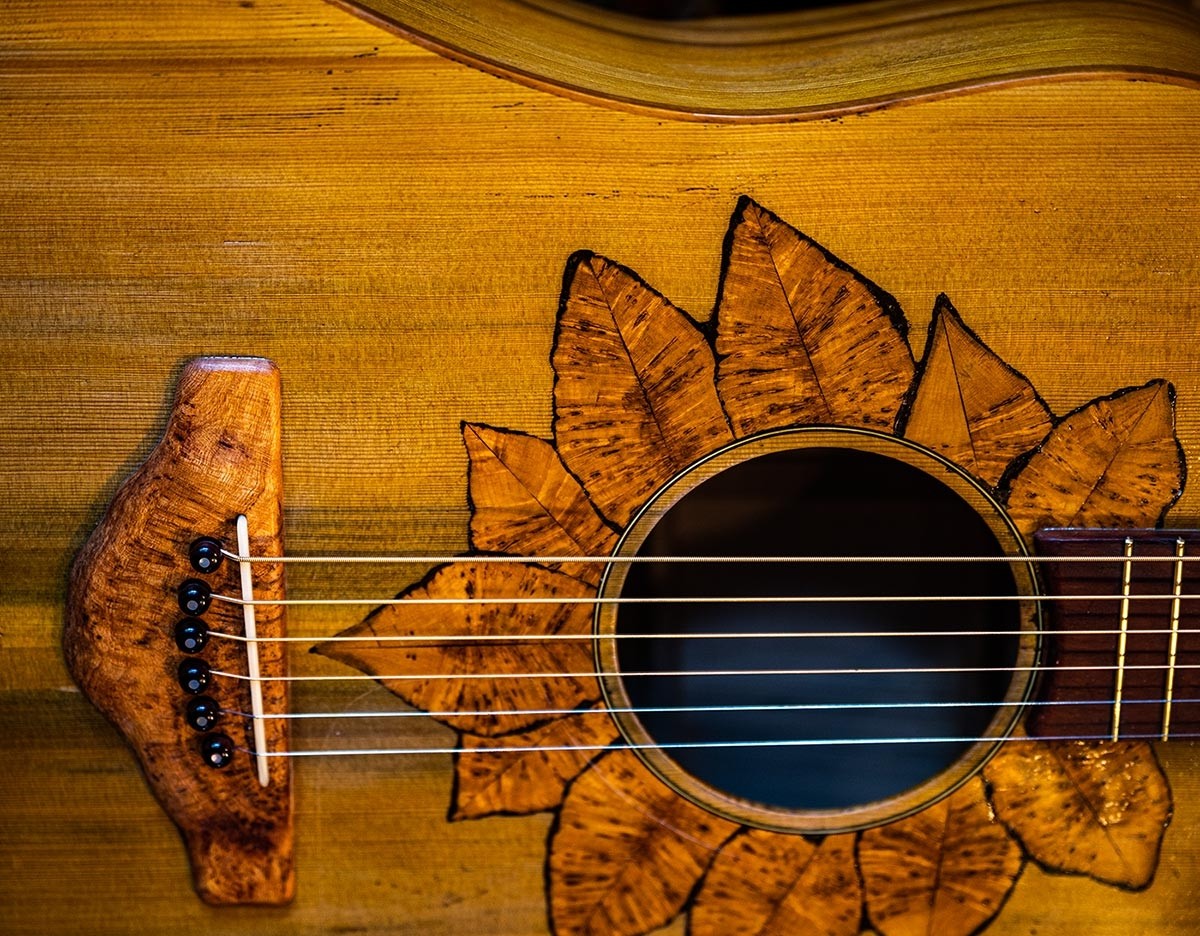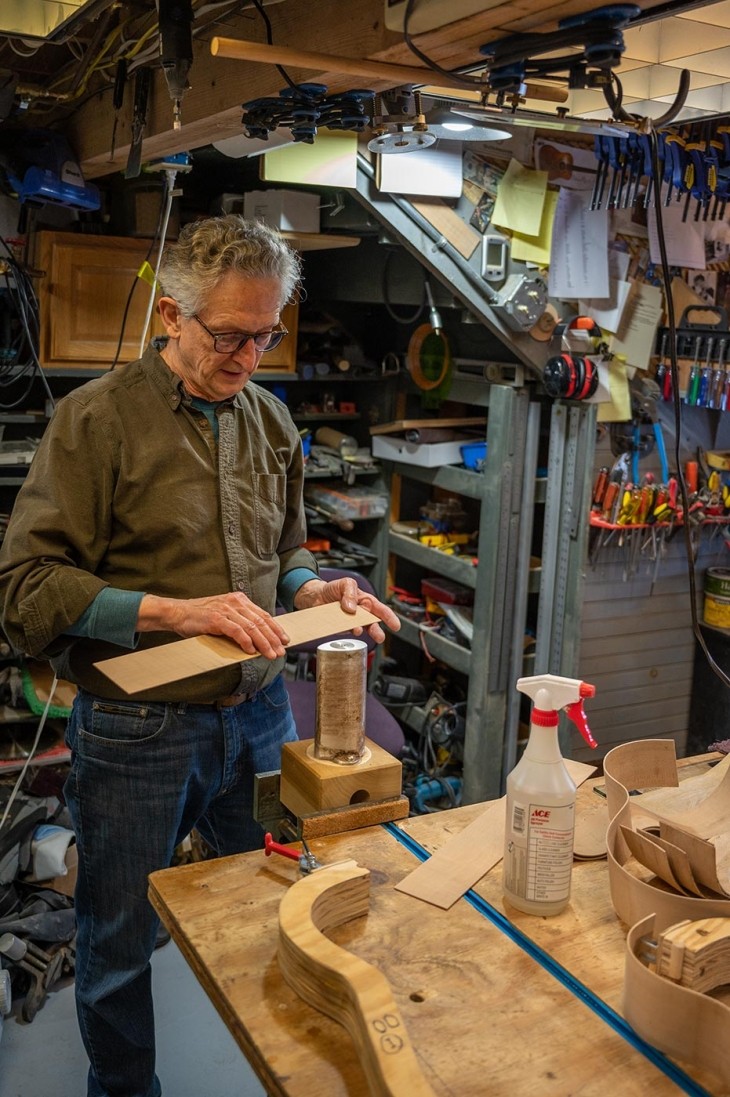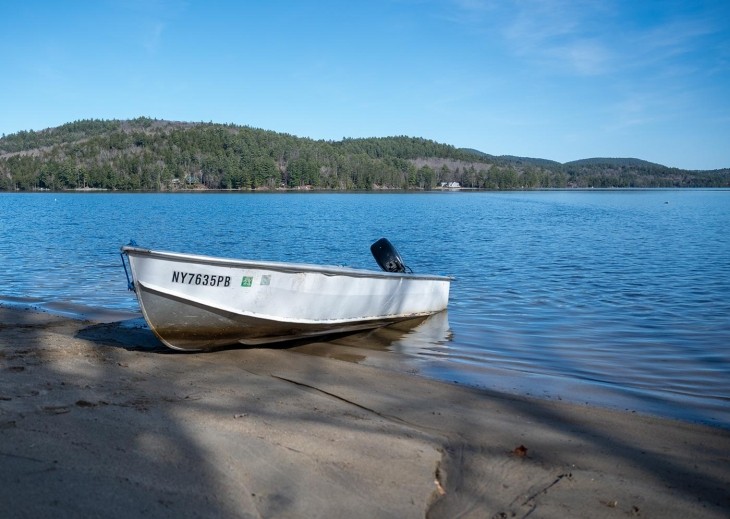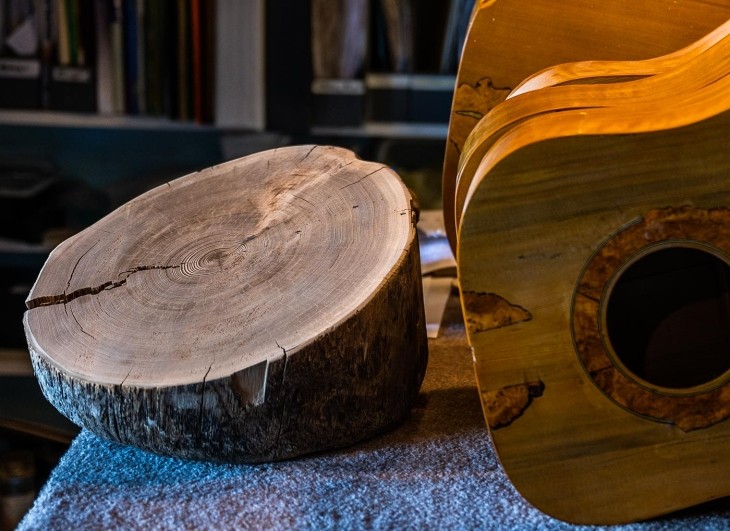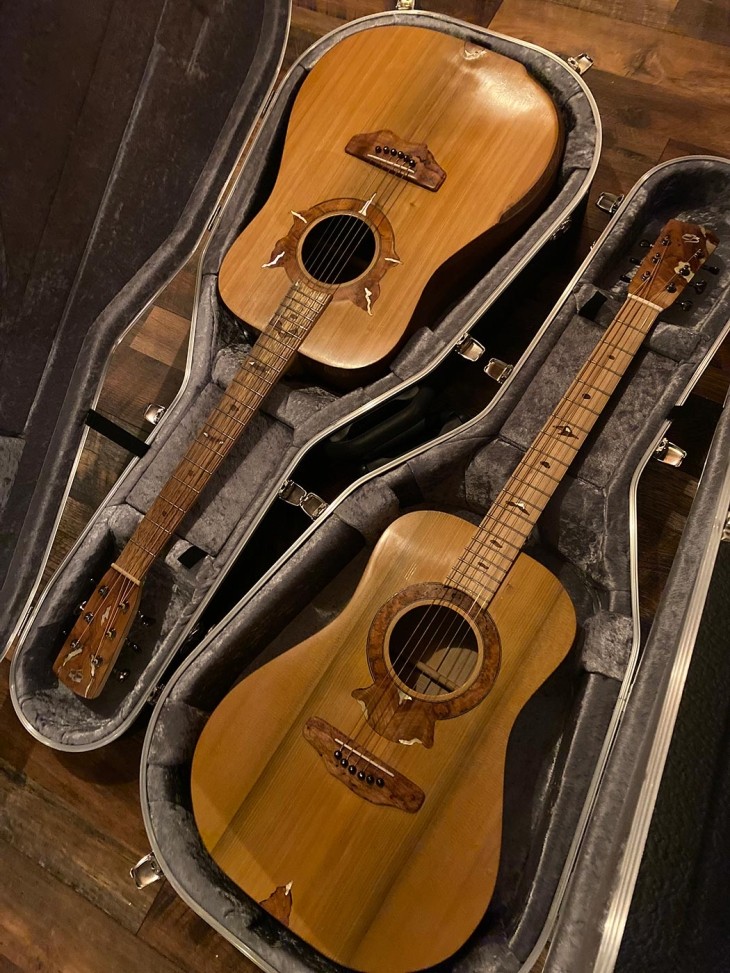When I first heard of Eric Bright’s custom-built guitars, I knew I needed to find a way to see and play his instruments. I had been researching the period of intense logging that stripped the Adirondacks of much of its mature timber in the late 1800s, and was learning about log drives through Schroon Lake, when I stumbled across Bright’s BassRock Guitars website. There, I read how Bright recovered sunken logs from the lake and transformed them into handcrafted guitars. I wanted to know what a guitar built from this timber sounded like, and what it took to resuscitate a log that had been submerged for 150 years and to turn it into a guitar.
On a cold and sunny March morning, I pulled up to the BassRock Guitars showroom in Schroon Lake, New York. Bright greeted me at the door with a broad smile and a firm handshake. Sunlight streamed through the windows, illuminating the guitars adorning every wall. A few of the more valuable instruments hung inside climate-controlled display boxes with glass windows. Bright introduced me to his luthier apprentice, Beth Melecci, and invited me to take a seat.
During the next two hours, Bright handed me every guitar in the room. I marveled at each, turning them over to take in the intricate detailing on every surface. As I strummed, Bright and Melecci sat across from me, asking me what qualities I was hearing in each instrument and offering their own analyses. Bright was observant and kind, and endlessly inquisitive. He noted that people vary in their preferences for tonal characteristics in guitars, and said that he was always curious which of his guitars a visitor would gravitate toward. It was clear that Bright valued these sessions as research – an opportunity to sit on the other side of his creations and, through others’ words and playing, contemplate the differences in each of his instruments.
Although each guitar had its own unique sound, I noticed that they all shared a warm, tonal quality – a kind of resonance often associated with vintage acoustic guitars. The low notes resonated deeply, and the mid- and high-range notes were bright and crisp. Bright attributed these qualities to the unique wood recovered from the bottom of Schroon Lake.
I asked Bright if I could return to interview him and to take photographs of his process, and he invited me to visit in the spring, after Schroon Lake’s ice-out, so that he could bring me by boat to his workshop. This was located in the basement of his family’s house on the east side of the lake. The house is inaccessible by road, so the family uses their boat to cross the lake in the summer, and snowshoe or cross-country ski over the lake in the winter.
On the first weekend in May 2022, we made the journey across the lake and Bright gave me a tour. A hanging rack of his most recently built guitars greeted me in the entryway. The walls of his workshop were covered with carefully organized tools, jigs, and materials; Bright described how he could move the tables and workbenches around to accommodate various tasks. A wood stove and a humidifier filled the remaining space. Bright explained that he carefully managed the temperature and humidity of the workshop throughout the year. We discussed the way he sourced his materials, how he prepared these, and how he crafted his guitars.
I had planned to make another visit last autumn, and perhaps to watch Bright salvage logs. Sadly, he passed away in an accident in June 2022. His daughter Kate graciously shared details about Bright’s unique process that I hadn’t learned in our previous meetings. It is a privilege to document aspects of his work and to celebrate his legacy.
Salvaging Sinker Spruce
Bright began playing guitars as a teenager, but he only began building them 15 years ago, after taking a weeklong course with luthier David Nichols in Malone, New York. At the time, Bright was preparing to retire from a career in special education, and he was ready for a new creative outlet. After building his first guitar, he was hooked. He soon developed an approach that blended traditional luthier methods with his own artistic flair. He wanted to make guitars that looked as if they could have been grown in the woods, rather than crafted in a shop.
Bright enlisted Kate’s help and began searching along the bottom of Schroon Lake. He knew that nineteenth-century log drives had passed through the lake and that many of the logs that sank during drives had not been recovered. Many of these “sink logs” are old-growth Adirondack red spruce – one of the most sought-after woods for guitar tops. Their tight, even wood-grain patterns resonate deeply and produce a rich, warm, and crisp tone that guitar builders and players cherish.
Bright’s salvaging process required a snorkel, a 14-foot aluminum fishing boat, and a long length of braided rope. He would snorkel along the shore, searching for long, silt-covered mounds (the standard length for logs harvested in the 1800s was 13 feet by 4 inches). When he found a log, he would excavate one end and secure a rope around it. Then, standing on the prow of the boat, he and Kate worked together to hoist the log out of the silt. They would tow it to their house on the edge of the lake and roll it onto the shore.
Once on shore, Bright would inspect the log. Many Schroon Lake sink logs still have proprietary markings on one end, made by loggers using stamping hammers. Bright referenced historical records to match these marks to the woodlot where the tree was harvested. He would cut off the ends of the log to age the tree and to identify its species based on grain pattern and smell. On one of the larger-diameter Adirondack red spruce logs he recovered, Bright counted more than 300 growth rings. Given that the tree was felled in the 1800s, it was growing as early as the 1500s.
Bright would leave the logs on the shore for a few months before transporting them up the hill behind his house to a shed, where they would continue to dry. The wood was milled twice to get the required dimensions for different guitar parts and to continue the gradual drying process. In particular, he was careful to save the center of large-diameter logs with tight growth rings for bookmatched guitar tops and backs. He would drum sand them to their final thickness. He stacked shelves full of wood blanks in his workshop, where they would spend years aging before they were ready for use.
An Organic Aesthetic
The unique characteristics of Bright’s guitars go beyond his use of salvaged wood. For example, in addition to using abalone pearl, a traditional material for inlays, Bright used tree burls. With a bandsaw, he cut book-matched slices from burls, carved a corresponding shape out of the body of the guitar, glued the burl slices into the guitar, and then sanded them down to create one seamless, flat surface. Bright strived to create organic shapes that suggested patterns found in nature.
During our visit last May, Bright told me how his extensive inlay work might make more traditional luthiers cringe because of the potential impacts on sound quality. But these unique burl designs were essential to his vision, and he didn’t think they diminished the sound quality of his instruments. He had cabinets full of burl slices, and he would carefully select from these to complement the rest of the guitar’s wood color and pattern. The bridges of Bright’s guitars – the small pieces of wood that secure the strings below the sound hole – are also shaped from burls, adding to the instruments’ organic aesthetic.
Bright worked in batches, building roughly a dozen guitars each year. First, he decided on the style of guitars he wanted to build and picked out the bookmatched tops. Then he progressed through building and assembling the neck, sides, top, and back of the guitar. Rather than create model lines of identical pieces, Bright strived to create unique instruments with each build, and gave them each a name that he believed reflected their tonal and aesthetic qualities.
Opening Up
When Bright finally strung up his annual batch of guitars, his work was not over. Next came the “opening up” of the guitars. This is a common term among luthiers that describes how new instruments slowly develop richer sound.
“To build a guitar, we’re taking all these parts and bringing them into one machine,” Bright explained. “The different parts are fighting each other in the beginning, with the grain going different directions. As you play, the guitar is learning to resonate as one piece. And it only does that if you work at it.”
Bright played his new guitars often. Some would start to open up within weeks or months; others would take a year or more before he was ready to showcase them. Bright told me that his guitars tended to open up more quickly than typical wooden guitars, and he attributed this to the sinker spruce. He said that he sent a sample of the wood to a researcher at the State University of New York College of Environmental Science and Forestry (SUNY-ESF). The researcher found that mycelia – networks of fungal growth – had invaded the cells, a result of the logs being submerged for decades. Bright hypothesized that as the fungi consumed nutrients from the wood, the cells became more porous, and the wood resonated more freely.
A Family Legacy
Many customers discovered Bright and BassRock Guitars at trade shows around the North Country. A fellow Schroon Lake resident, Eric Lendrum, first met Bright at a show 10 years ago. Lendrum loved everything about the guitars – their sound, their connection to the history of Adirondack Park, and their artistry. Although he hadn’t thought of himself as someone who would purchase an expensive, custom guitar, over the course of years of talking with Bright and playing his guitars, he fell in love with the instruments – and the idea of owning one.
Lendrum’s wife bought him a BassRock guitar in 2021 for his birthday. That guitar is named “Melanie,” which is also the name of one of the Lendrums’ daughters. In August 2022, upon hearing of Bright’s passing, Lendrum bought a second guitar, “Mirabelle.” Both of his daughters are budding musicians, and he wanted each of them to have one of Bright’s instruments.
“There are few things in my house that I know will be in my family for the rest of my life and beyond,” Lendrum said. “But we know that these guitars will be. They are a piece of our community, our culture, our history.”
Today, Bright’s daughters, Kate and Lydia, continue to run BassRock Guitars. Kate estimates that her father built and sold between 40 and 50 guitars over the course of his career as a luthier. He was in the process of building four additional instruments in 2022, which will be finished by Beth Melecci, in collaboration with another local luthier. These four, and the thirteen currently for sale at the time of this writing, will be the last of Bright’s guitars sold.
“Much of the process was perfected and personalized by Dad and unknown to anyone else,” Kate explained by email. “If more were going to be made in the future, they would not have the Eric Bright touch.”
The family plans to keep several guitars – part of Bright’s legacy that encompasses far more than his craft. “He was a loving husband of 50 years, a father, and grandfather,” Kate told me. “He was eager to share his passions and love of guitars, woodworking, music, and Schroon Lake. His creativity, care, and passion resonated through everything he did and everyone he talked to. He was a rare individual in that he truly listened to people when they talked and wanted to make meaningful connections and keep them. Throughout his life, he definitely gave more than he received.”


